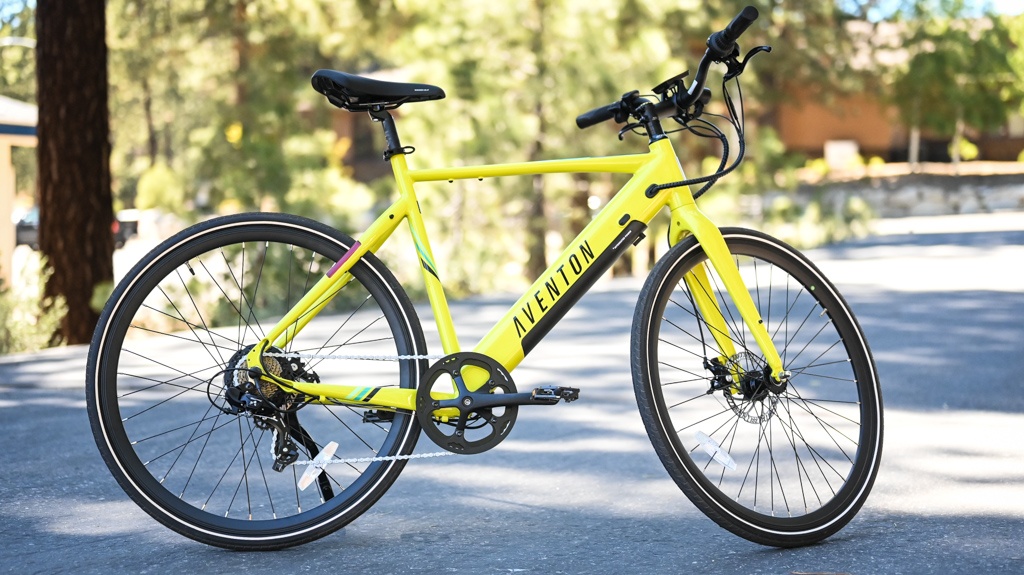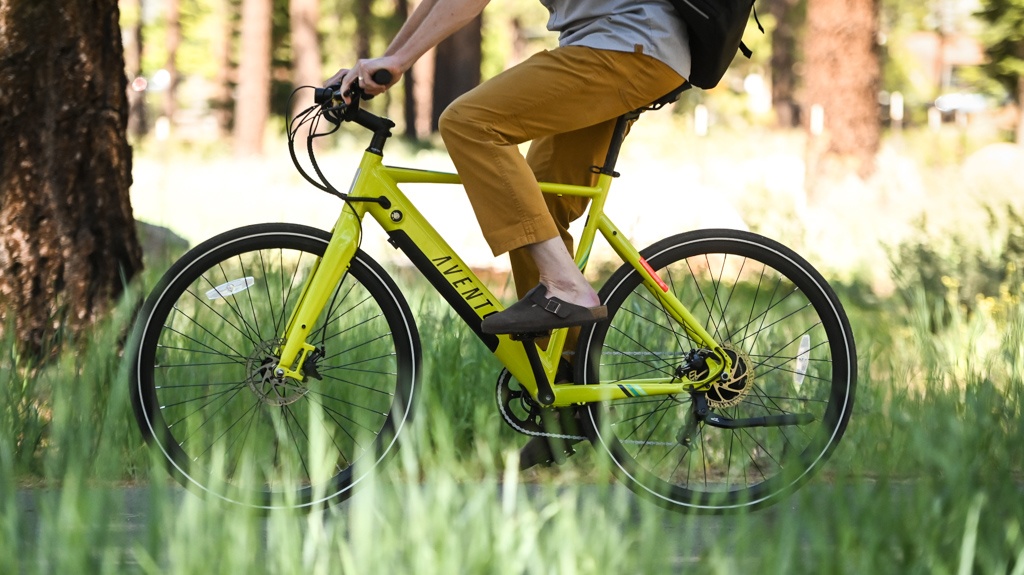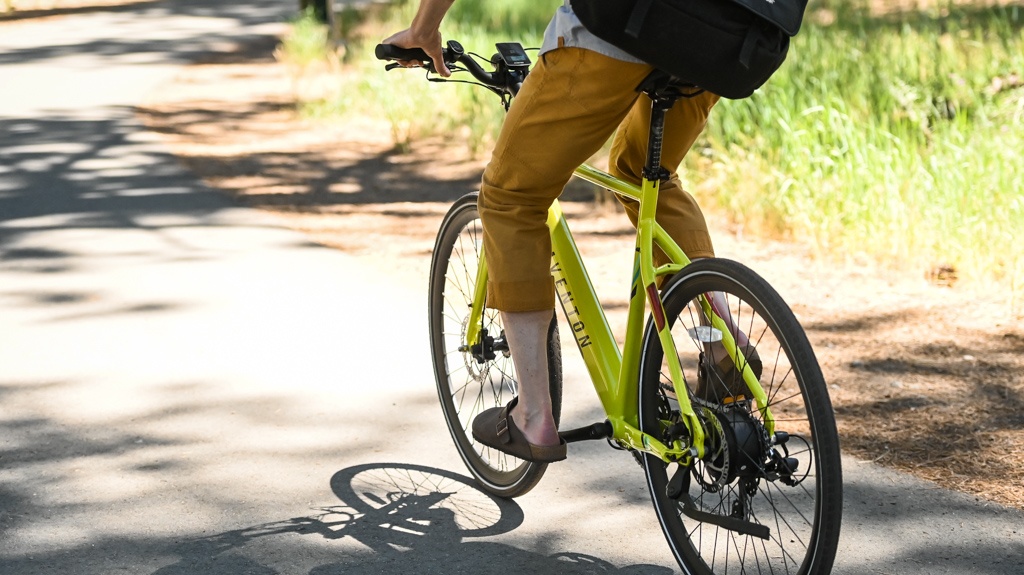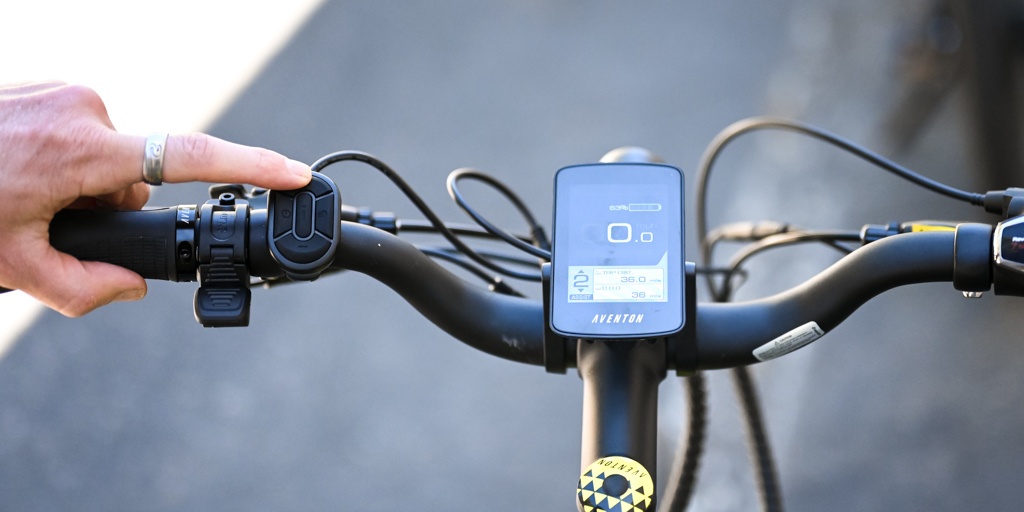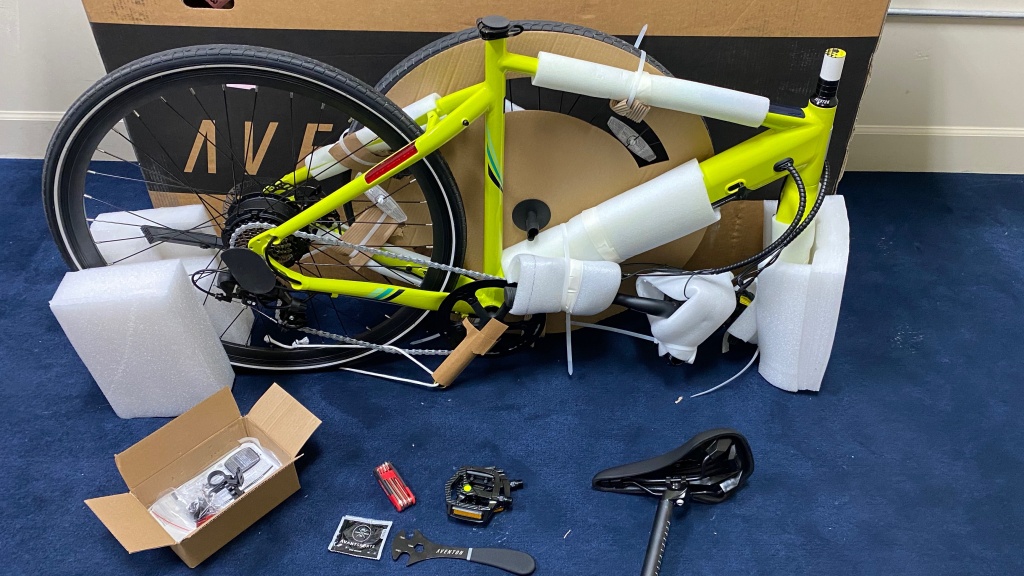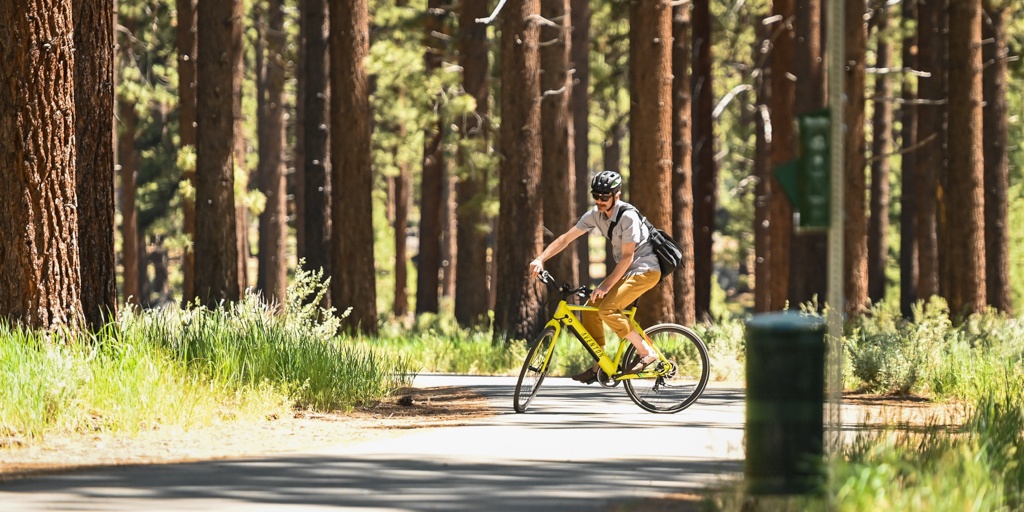Aventon Soltera Review
Our Verdict
Our Analysis and Test Results
Aventon makes a full range of electric bikes for commuting and recreation, and the Soltera is one of the newest and least expensive models in their lineup. This sleek-looking bike has very clean battery integration, a city bike style, and is lighter weight than most other models we tested. This Class 2 model can support speeds up to 20 mph using the throttle or pedal assist, it rolls fast, and has quick, responsive handling. Available in 2 sizes and both step-over (tested) and step-through frame styles, as well as three colors per frame style, you can be sure to get a bike that suits your needs and preferences. After weeks of testing, we came away quite impressed and feel it is a top-ranked budget electric bike for tackling your daily commute or zipping around the city.
Performance Comparison
Ride
The Soltera has a city bike style and the ride quality to match. Its handling is quick and precise, and it rolls fast and smooth on 700c wheels and tires. Its geometry is on the more aggressive side, and it requires a slightly more athletic body position that suits this style of bike well. The component specification is budget-minded but perfectly functional, and it can be purchased with a 7-speed drivetrain (tested) or as a simple single-speed (which costs $100 less).
Aventon has roots in the fixed gear bike market, and the design of the Soltera appears to be a nod to that style of bike. With a rigid frame, 700c wheels, and skinny tires, it has a real city-bike look and feel and the handling that comes with it. This bike is quite agile, with responsive, sporty handling. It turns on a dime, yet it likes to roll fast, feels stable at speed, and is comfortable making a variety of turn shapes. The flip-side of that coin, however, is that the rigid frame and lower volume tires don't absorb vibration all that well, and cranks or bumps in the road can feel a little harsh.
The Soltera has a 300 lb weight limit, and the step-over version we tested comes in two frame sizes. The regular has a recommended user height range of 5'1" to 5'7", while the large is made for riders between 5'7" to 6'4", so most riders should be able to find a good fit. Our size large test bike was a perfect fit for our 6'0" inch tester with long legs, with ample seat height adjustment to spare. Additionally, the Soltera comes in a step-through frame for those who prefer that style. The step-through frame also comes in two sizes with the S/M designed for riders between 4'11" and 5'7" and the M/L for riders between 5'7" and 6'1". Along with the city bike looks, it also has a city bike feel, with a somewhat more aggressive and athletic body position. It doesn't require the rider to break too much at the waist, but it is notably less relaxed than many of the other models we've tested. It comes with a performance-oriented bike saddle that is fairly narrow, but we found it to be quite comfortable, and so are the ergonomic grips.
The Soltera can be purchased with either a single-speed or 7-speed drivetrain. We chose the 7-speed option as it is better suited to the somewhat hilly terrain near the GearLab HQ. We found the 7-speed Shimano drivetrain to work well, and the twist shifter is intuitive and easy to use. Those who live in flatter areas could save a few bucks by opting for the simpler single-speed drivetrain. Our bike came equipped with mechanical disc brakes that aren't the most powerful, but they work well enough to control your speed. The single-speed version comes with rim brakes. The Soltera is relatively light on features, but the few included extras are a nice touch. It comes with lights that include a relatively bright headlight and rear lights that are neatly integrated into the seat stays and work like brake lights when they are applied. A bell is also integrated into the left brake lever so you can warn others as you approach.
Range
The Soltera performed relatively well in our range test, and we were impressed by its performance given its moderately sized 346 Wh battery capacity and the overall lighter weight of the bike. This test was performed using the throttle only, so we feel our results represent the absolute low-end of its range potential.
During our test, we rode the Soltera for a total of 18.8 miles with 1,057 feet of elevation gain/loss. This test took just over an hour and six minutes to complete, giving us an average speed of 17 mph. While this is far from Aventon's claimed 41 miles average range, riding for nearly 19 miles without pedaling is still quite impressive. We feel the moderately powerful 350W motor makes relatively efficient use of the battery, and the larger 700c wheels certainly roll fast and maintain speed quite well. During the test, the Soltera managed to scoot right along at its top throttle speed of 20 mph in the flats, but it slowed a bit while climbing some of the rolling hills on our test course. We think it's very safe to assume that one could ride this bike a bit farther on perfectly flat terrain and that you could easily double its range, or more, using pedal assist and putting in some pedaling effort.
Power
While it is far from the most powerful electric bike we've ever tested, the Soltera holds its own and earned an average score in this metric. It may not be zippiest, but the 350W motor has no problem scooting this Class 2 model along at 20 mph using the throttle or pedal assist.
Compared to other models with more powerful motors, the Soltera feels a little sluggish in its acceleration. We performed some tests behind GearLab HQ, and it was able to go from a complete stop to its top throttle speed of 20 mph in 16 seconds pretty consistently. That's certainly not bad, but it is notably slower than a few other models we tested. Once up to speed, it maintains it quite well, especially on flat ground. Larger wheels are typically a little slower to accelerate but they carry speed quite well, and we found that was exactly the case with the Soltera. On our uphill acceleration test, the 350W motor did a respectable job, getting up to 12 mph before slowing to around 10 mph at the steepest part. Again, not super impressive, but realistically, you should be pedaling uphill anyway. We were very pleasantly surprised, however, but its 17 mph average speed during our throttle-only range test. The course features numerous gradual rolling hills and the Soltera seemed to be able to maintain its speed quite well. We think this is largely due to the wheels and tires that roll fast and maintain momentum.
The Soltera has 5 levels of pedal assist, and it can be ridden without power as well. The amount of pedaling support and the top assisted speed increases incrementally as you shift up through the levels, providing a great range of assistance to suit varying needs and situations. We found the power delivery to generally feel quite smooth, with noticeable increases in output as you shift up through the levels. Power delivery is based on a cadence sensor, so it provides the same amount of support as long as the cranks are turning, regardless of how much effort you're putting into the pedals. Should you run out of battery or choose not to use the power, the Soltera rides surprisingly well thanks to its comparatively light weight and snappy city bike design.
Interface
The Soltera comes with quality handlebar-mounted controls and an excellent color display earning it high marks in this metric. Using this bike is straightforward and intuitive, plus you have option to sync the display with the Aventon app to make changes to the settings or share rides with the Aventon community. The battery is cleanly integrated into the downtube of the frame, and it can easily be removed for security or charging purposes.
The controls consist of a paddle throttle by the left grip which is very easy to reach, and it has a little texture to keep your thumb in place. Next to that is a small control unit with five buttons. The power button is on the left, + and - at the top and bottom, a light button on the right, and the info button in the middle. These buttons are all fairly easy to reach with the thumb while riding, and each button has its own purpose, and their use is quite intuitive compared to some controls with multi-function buttons. The display is centered on the handlebar above the stem in an easy-to-see location with a relatively large screen that measures 2-¼ x 1-¾-inches. The screen is primarily black and white with a few splashes of color, and is very easy to read. The top of the screen has a battery graphic with 5 bars representing the remaining charge, along with the battery percentage as a number. We think showing the remaining battery life as a percentage is fantastic, and something found on only a few of the models we've tested. Below that in the center of the screen in large numbers is your current speed. At the bottom on the left is your pedal assist level shown as a number (0-5) along with two info boxes that can be switched by pressing the info button. Default is trip distance and odometer, and you can switch between average speed/max speed, trip time/calories burnt, trip CO2 reduced/trip trees saved, and sum CO2 reduced/sum trees saved.
The Aventon app is a cool feature found on the Soltera and few, if any, other bikes in this price range. The app was debuted with the Aventure bike and has since found its way onto most other bikes in their range. It allows the user to connect to their bike, change settings, record rides, track data, and share photos of adventures with others in the Aventon community. We've spent a little time using the app and feel that it is a cool feature, and certainly a novel one for a bike in the “budget” category.
We think Aventon did a great job with the design of the Soltera, particularly the clean integration of the battery into the downtube of the frame. To casual passers-by, it hardly even looks like an electric bike at all. There is a charging port with rubber cover on the right side of the frame, and the battery can also be easily removed for charging or security using the key and pulling it out from the underside of the downtube.
Assembly
The Soltera was relatively easy to assemble, earning it one of the highest scores in this metric. Like most electric bikes, it arrives mostly assembled with only a few steps remaining to get it ride-ready. Unlike most other models, however, it weighs just 44 lbs and 5 oz, making it a bit easier to handle in the box and remove from it.
As mentioned above, the Soltera is lighter than most, so moving it around and removing it from the box is fairly easy. Once removed from the box, you need to remove all the protective packing materials, but it's mostly put together. It comes with printed instructions and tools (a folding multi-tool, a wrench, and a packet of bike grease), and there is a helpful assembly video on the Aventon website. The remaining assembly steps include installing the stem/handlebar (already attached together), attaching the front wheel, the seat/seatpost (already together), and pedals. It took our testers about 25 minutes to complete the process. Of course, you also have to plug it in for charging, pump up the tires, make some comfort adjustments, and then it's ready to go.
Should I Buy the Aventon Soltera?
The Soltera is a reasonably priced e-bike with responsive handling, a streamlined design, great battery integration, and city-bike style. It's not the most powerful bike in the world, but this Class 2 model easily tops out at 20 mph using the throttle or pedal assist, and we found it has a respectable distance range with its 346 Wh battery. It is offered in step-over (tested) and step-thru frames as well as 7-speed (tested) or single-speed drivetrains to varying rider heights and preferences. At just 44 lbs and 7 oz, the Soltera is easier than most to carry up and down stairs or load onto a bike rack, and we feel it is a great option for urban environments, commuting, or just getting out and having fun.
What Other E-Bikes Should I Consider?
Interested in something a little more powerful? The Ride1Up Turris XR is a reasonably priced Class 3 model with a 750W motor that boasts pedal-assisted speeds up to 28 mph. It has a more relaxed seated pedaling position and a smooth, comfortable ride, though it's not quite as agile as the Soltera. That said, it's way more powerful.


